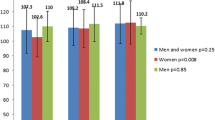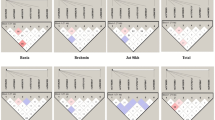Abstract
Aims/hypothesis. Peroxisome proliferator activated receptor γ coactivator-1 (PGC-1), a transcriptional coactivator of the nuclear receptor PPARγ, plays a role in adaptive thermogenesis and insulin sensitivity. Plasma fasting insulin has been linked to the chromosomal region where the PGC-1 gene is located. Thus, PGC-1 can be viewed as a functional and positional candidate for the susceptibility gene for Type II (non-insulin-dependent) diabetes mellitus.
Methods. After screening the PGC-1 gene for single nucleotide polymorphisms (SNPs), we performed an association study using the newly detected SNPs in 537 Type II diabetic patients and 417 non-diabetic subjects.
Results. We found three relatively frequent SNPs in the PGC-1 gene (IVS4-11T > C, Thr394Thr and Gly482Ser). There were significant differences in fasting insulin (Gly/Gly; 37.7 ± 1.43, Gly/Ser; 40.2 ± 1.21, Ser/Ser; 44.3 ± 1.82 pmol/l, p = 0.018) and insulin resistance index (Gly/Gly; 1.48 ± 0.06, Gly/Ser; 1.56 ± 0.05, Ser/Ser; 1.75 ± 0.08, p = 0.027) according to the genotype of the Gly482Ser polymorphism. The Thr394Thr – Gly482Ser haplotype was associated with Type II diabetes (p = 0.00003).
Conclusion/interpretation. The results of this study suggested that the PGC-1 gene might be implicated in the pathogenesis of Type II diabetes.
Article PDF
Similar content being viewed by others
Avoid common mistakes on your manuscript.
Author information
Authors and Affiliations
Additional information
Electronic Publication
Rights and permissions
About this article
Cite this article
Hara, K., Tobe, K., Okada, T. et al. A genetic variation in the PGC-1 gene could confer insulin resistance and susceptibility to Type II diabetes. Diabetologia 45, 740–743 (2002). https://doi.org/10.1007/s00125-002-0803-z
Received:
Revised:
Published:
Issue Date:
DOI: https://doi.org/10.1007/s00125-002-0803-z




